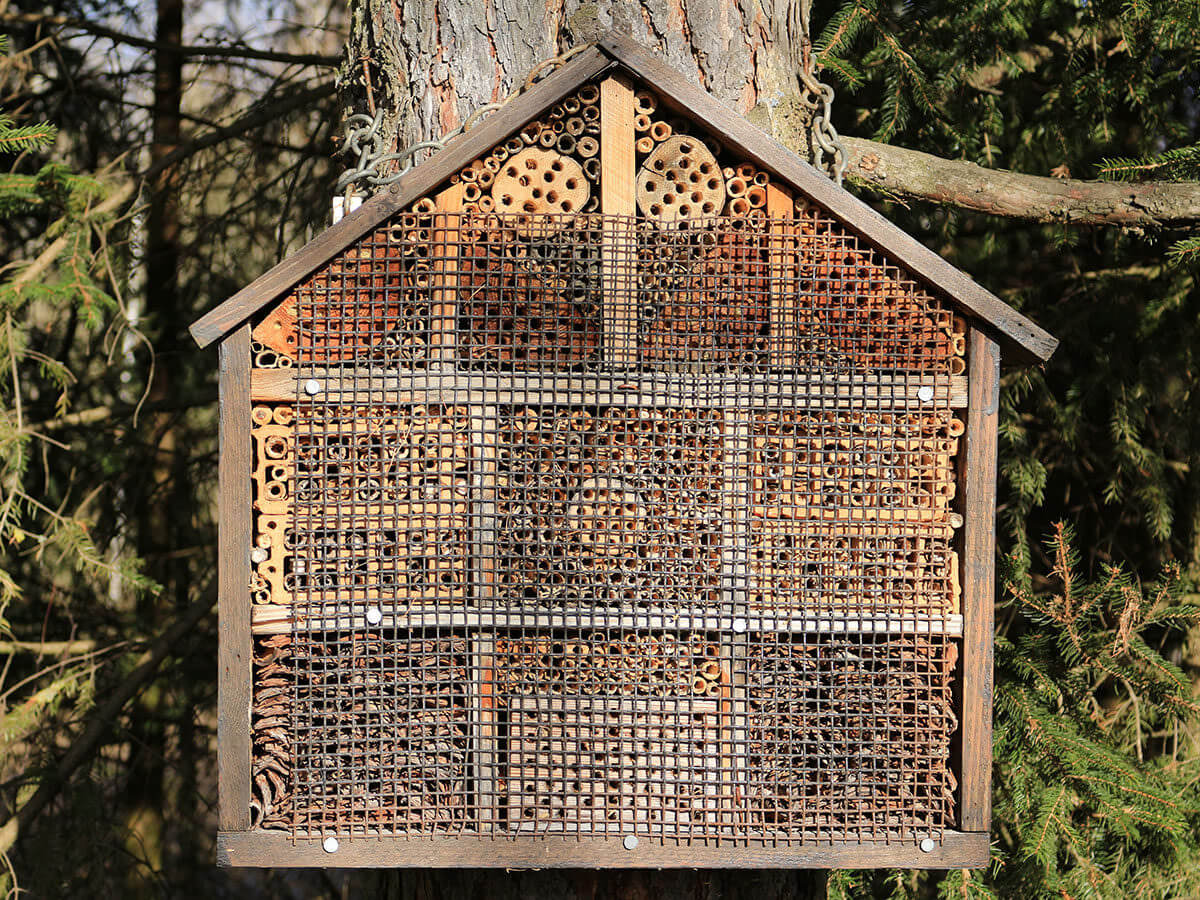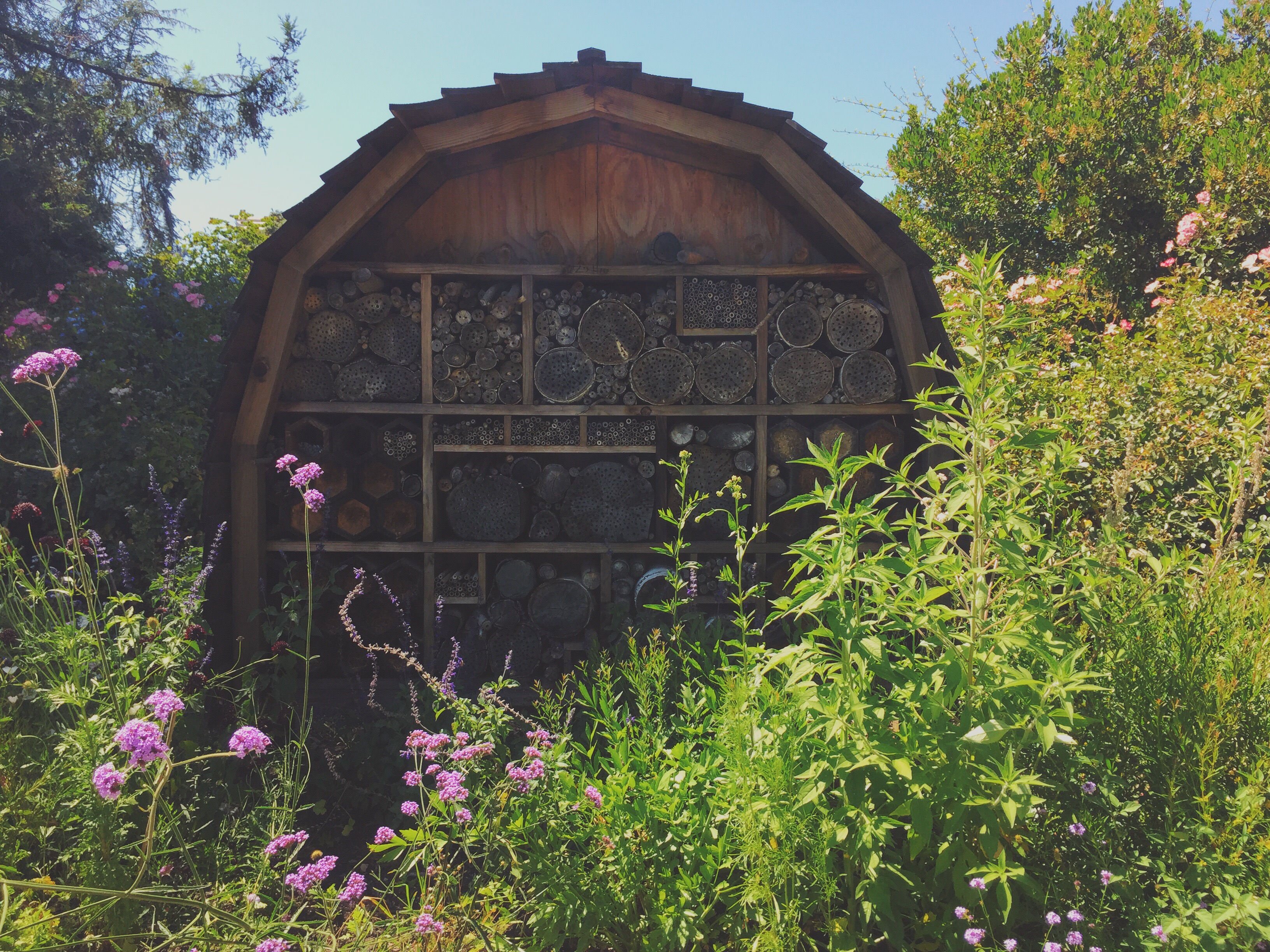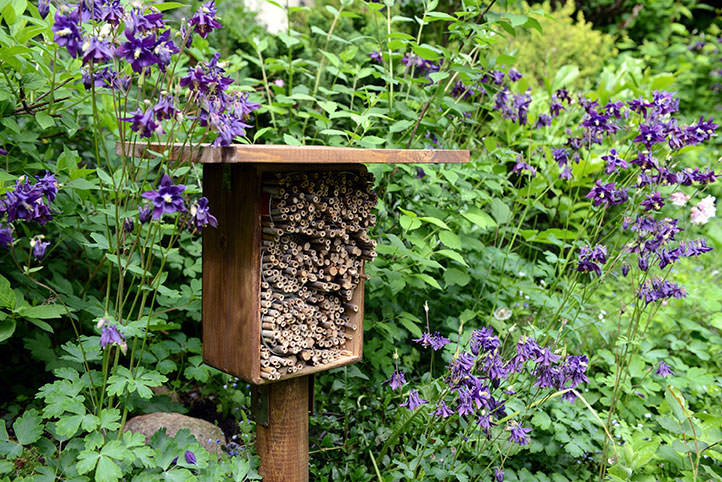These unsung workhorses deserve a place in your garden, too.

We think of bees as hive creatures with a nasty sting. But not all bees live in hives or have such an aggressive approach to self-defense. In fact, the great majority of native bee species live a solitary lifestyle and have puny stingers, which are virtually harmless and rarely used.
Many of these so-called “solitary bees,” which include mason bees, leafcutter bees, and carder bees, look more like a flying ant than a fuzzy yellow bee, but they’re valuable pollinators just the same. The traditional hive boxes used to house honeybees does nothing to attract native bees to your garden, but these unsung heroes will happily take up residence in a “bee hotel,” where each can have a private room of their own.
“Communal bees” would be a more apt name for native bees, as most like to live in close proximity to one another, just not in the highly social confines of a hive (some of us can surely relate). Instead, they look for narrow tubular spaces, such as the hollow center of a reed or a crevice in a rock wall, where they can safely lay eggs and incubate their young. It isn’t easy for a tiny bee to find the perfect home, especially in the city, so if you create the ideal living space – an easy hour-long project, requiring little more than a few scraps of lumber, some screws, and an electric drill – they will come in droves.

A bee hotel in the pollinator garden at The Gardens at Lake Merritt in Oakland, California.
[mf_h2 align=”left” transform=”uppercase”]Step One: Build a Frame[/mf_h2]
The exterior walls of a bee hotel may be made with almost any lumber scraps you happen to have lying around. Freshly purchased pressure-treated wood should be avoided, though, as the chemicals inside will deter the bees. Older, weathered pressure-treated lumber is fine.
You can build the hotel as big as you want, and in any shape you want, though a rectangle about the size of a typical birdhouse (roughly 8” x 12”) is a common and easy to construct design. The only real requirement, in terms of dimensions, is that the frame be approximately 6 to 8 inches deep. 1” x 8” lumber (which is actually ¾” by 7 ¼” wide) is ideal.
The frame must be enclosed at the back – lightweight plywood cut to size is perfect for this part – and open in front. The roof must be sloped to shed rain and must extend at least 2 inches over the front. You can use wood again, or, if you’d like, tack on a piece of corrugated metal roofing for a cute, barn-like bee hotel.
The wooden frame maybe left unfinished, coated with an exterior wood sealant to protect it from the elements, or jazzed up with colorful paint. Just know that the smell of paint and sealant is likely to deter bees for at least a few weeks until it wears off.
Native bees vary greatly in size; the bigger the bee, the larger the diameter and greater depth they require for their nest hole.
[mf_h2 align=”left” transform=”uppercase”]Step Two: Add “Rooms”[/mf_h2]
The hotel “rooms” are nothing more than holes drilled into blocks of wood. You can use random scraps of lumber or even small logs cut from tree branches. Whatever materials you use, they should all be cut to the same length, which is determined by the depth of the frame (a minimum of 6 inches).
Native bees vary greatly in size; the bigger the bee, the larger the diameter and greater depth they require for their nest hole. Drill holes ranging from 1/8” to ½” in diameter into the end of each block or log, spacing them about ½” to ¾” apart. Holes larger than ¼” should be 5” to 6” deep, while holes ¼” or smaller should be 3” to 5” deep. Make as many hole-filled blocks as well fit in the frame, and then smooth out the openings with sandpaper to remove any sharp splinters left by the drill.
You may also fill portions of the frame with small-diameter pieces of bamboo, hollow reeds, or plastic tubing cut to the same length as the wooden blocks. (While the image up top has some fencing covering in the front, that is completely optional; as the caption reads, it’s more of a luxury hotel.)
[mf_h2 align=”left” transform=”uppercase”]Step Three: Mount the Hotel[/mf_h2]
Mount your bee hotel on a fence post, exterior wall, or any other vertical surface with a couple of screws through the rear wall. It should be roughly chest high and facing south if possible, so it warms up earlier in spring and stays warm later in fall, extending the egg-laying season for the resident bees. Stack the blocks, bamboo and any other bee rooms you’ve created inside the frame with the hole openings facing out.

The “apartments” in this bee hotel are made from hollow bamboo sticks. ( lcrms/shutterstock)
Female bees will construct individual chambers throughout each hole with mud, chewed up plant material and other substances, depending on the species. A single egg is deposited in each chamber, along with a bit of pollen for the baby bees to eat after they hatch. Once a tube is filled, it will be sealed off at the opening to prevent moisture and predatory insects from entering.
The hatched bees remain inside the sealed tubes through the winter, emerging as adults in spring when warm weather returns. After all the sealed openings have been broken by the exiting bees, bee experts recommend removing the old “rooms” and building a new set each year as a precaution against transmitting diseases from one generation to the next.
Don’t place in shade or it will attract wasps.
Place where the southeast morning sun strikes it, & attract pollination lone bees and the occasional beneficial native lone wasps.
Thank you. I’ve shifted through lots of information in this subject and this is the most relevant, detailed and informative advice I’ve read. I started with one shop bought insect hotel and last year I couldn’t make new hotels fast enough for all the different sized bees that came. This year is the same with swarms of bees searching for a room. And lots of last years seen hatching out. So interesting and amazing to watch and lovely to know I’m helping the wildlife.
Would this run the risk of attracting wasps or yellow jackets?
Thanks. I like the bee hotel idea. I’ll try it this year.
Thank you!
Really awesome idea, thanks. I look forward to making this.
Interested in what you have……
wasps & yellow jackets are also a concern of mine, so do these hotels attract them?
Thank you for this informative and straight-to-the-point resource for bee hotels, especially the recommended materials and dimensions, as well as placement and cleaning suggestions. We’re guiding Scouts to construct some hotels for community display and to promote bee habitat at a bee festival event this month, and this is resource is just what I need to get to work! Thank you!!
Is there maintenance required in the spring if you live somewhere like Minnesota that gets snow and cold?